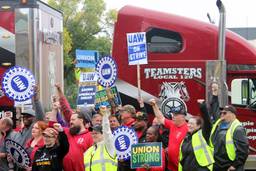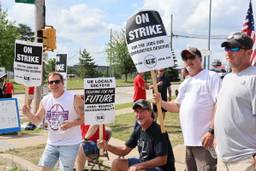Don’t believe the doctrinaire dismissal: workers centers are a crucial part of the labor movement
Once again, those of us who work at and think about workers centers are confronted by a labor writer’s first and last impression of workers centers: initial intrigue followed by a quick dismissal that boils down to this: They’re not unions, so they don’t do organizing, so they are for all intents and purposes irrelevant.
It’s unfortunate that so many who write about the labor movement have such a limited understanding of what organizing is and what makes a movement, as the labor movement purports to do, “move.”
The piece I’m referring to—“But Is It Organizing?”—has been making the rounds in the leftosphere. The piece appeared on Talking Union, a the labor blog of Democratic Socialists of America (DSA), and was authored by Bob Roman, who edits New Ground, the publication of DSA’s Chicago chapter. It’s been posted on the left-wing listserv Portside and elsewhere.
First off, even the briefest of perusals of contemporary and historical models of organizing should indicate that “old-fashioned union organizing” is not the only model of making change through “people power.” In fact, good old-fashioned, pre-AFL labor organizing often looked a lot like the organizing that workers centers, especially the Restaurant Opportunities Center (ROC)—which is mentioned in the piece — do right now. If the only valid result of organizing is an increase in union density, then what of the work of Highlander Center and other groups in the civil rights movement that transformed ordinary folks into civil rights leaders and activists?
Is community policing, a model similar to what workers centers do with grassroots enforcement of labor laws, not organizing? What of the feminist rape crisis centers that leveraged a social service into a movement that changed policy and attitudes around rape? Is it possible that workers centers are “relational platforms” that bring together allies (even unions!) and workers in ways that build movements that improve conditions of work for low-wage workers? Is it possible that workers centers provide a physical and ideological space for low-wage workers and allies to be “labor activists” in ways that unions can’t? Is any of that organizing?
Workers centers aren’t unions and don’t do union organizing because of the state. And not for the reasons noted in the piece — the idea that workers centers are somehow reliant on the state to advocate for low-wage workers — but because the state shapes the context in which any organization or social movement operates.
Does Roman assume that Pinkerton detectives no longer attack union organizers because of the good will of employers? Perhaps we can assume that the NRLA and the Wagner Act had something to do with legitimating and protection unions.
The strong dichotomy that many writers assume exists between unions and workers centers is not (completely) due to the latent anarchism of workers center leaders or the conservatism of mobbed-up labor union bosses, but because of American labor law. Workers centers arose because the constraints of the legal framework governing unions are significant obstacles to “organizing” (in the union sense) large numbers of workers in the modern economy.
Besides, the notion that workers centers are reliant on the state is wrong. Workers centers have an ambiguous relationship to state and federal Departments of Labor, even the “new” federal DOL under Hilda Solis. DOL complaints are either a last resort when direct action pressure fails, or part of a larger strategy that includes direct action and other mobilizing work. Workers centers use direct action and popular education to empower workers to enforce labor laws on their own. Is that organizing?
Permeating dismissals of workers centers is the idea that union density is the only appropriate measure of labor movement strength. That’s misleading. Certainly union density brings along all sorts of improved conditions for all workers. But on its own, it is not a complete measure of labor movement vitality. L.A. is often held up as a model of a progressive city, with a strong labor movement, but its union density is lower than New York and Chicago.
What is unique about L.A. is that activists and leaders have learned the lessons that the organizing that workers centers do is necessary but not sufficient to build a strong local labor movement in the same way that the organizing that unions do under current state regulatory frameworks cannot on its own rebuild the labor movement.
In other words, unions have one role and workers centers have another in building a movement that changes conditions of work for all workers. To ignore that lesson because of some doctrinaire version of what organizing is and isn’t is beyond counterproductive.

I hope you found this article important. Before you leave, I want to ask you to consider supporting our work with a donation. In These Times needs readers like you to help sustain our mission. We don’t depend on—or want—corporate advertising or deep-pocketed billionaires to fund our journalism. We’re supported by you, the reader, so we can focus on covering the issues that matter most to the progressive movement without fear or compromise.
Our work isn’t hidden behind a paywall because of people like you who support our journalism. We want to keep it that way. If you value the work we do and the movements we cover, please consider donating to In These Times.



